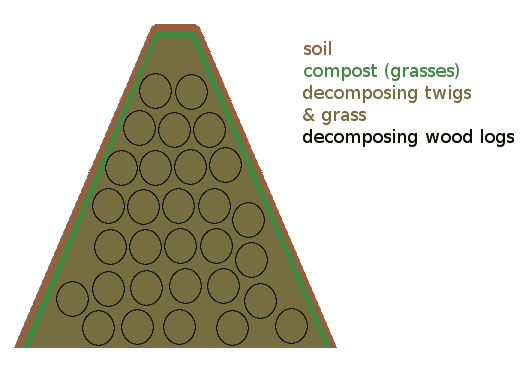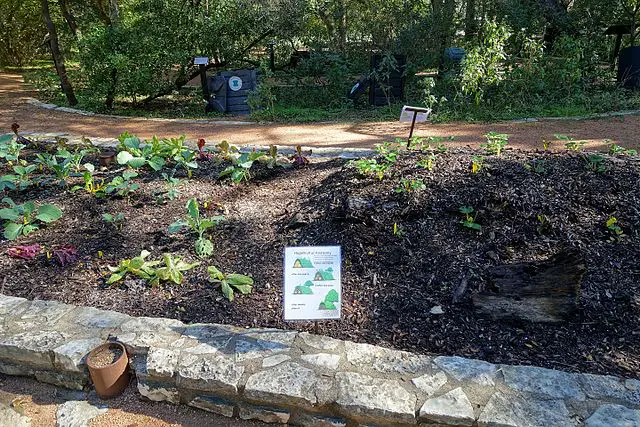Hugelkultur is a German word that stands for Hill or Mountain Culture. It is a horticultural technique in which the decaying wood and other decomposed plant material are used to build a mound that serves as a raised bed for planting a garden. Hugelkultur is earning fame among the home gardeners due to its low maintenance way of growing annual vegetables and flowers.
Wood is composed of varying concentrations of both primary nutrients (Carbon, Oxygen, Hydrogen, Nitrogen, Potassium, and Phosphorus) and secondary (Calcium, Magnesium, and Sulphur) nutrients. Buried wood decomposes slowly and becomes a source of a continuous supply of nutrients (for more than twenty years). This practice is often adopted in permaculture and has a long history.
To create your very own Hugelkultur garden, you simply stack up various sizes of deadwood and cover it with soil. You can use most types and sizes of wood, and you can sprinkle in any sort of organic matter that you have in your yard. Leaves and grass clippings will only add to the decomposition of the wood.
Why are you hauling away or paying someone to haul away your leaves, twigs, and grass clippings when they could be used to grow your next garden?
Table of Contents
History
As the word Hugelkultur belongs to the German language, you may have already guessed that it has been practiced in Germany for hundreds of years.
A comparison in plants’ growth rate grown on flatland and mound-culture was made. The results showed that the mound cultured plants were healthy (never expressed any nutrient deficiency and were never fertilized). The growth rate was fast, and the growing season was also extended due to the heat generation of buried wood.
Hugelkultur earned fame in Eastern Europe, Australia, America, etc., due to its remarkable benefits for both soil and plants. This is a principle permaculture technique followed by many gardeners and landscape designers.
The Science Behind Hugelkultur
“Sowing of seed to raise the seed again and use of wood to raise the wood again” is the logic behind Hugelkultur.
Hugelkultur is a biological, principles-based process. It is a large-scale, inexpensive, soil and microorganisms-friendly compost blended mulch placed under the soil surface. This decomposing organic material provides a very long-lived source of soil fertility and creates a very rich bed of thriving microorganisms below the plants. Building a Hugelkultur bed will give any gardener a very unique and healthy area to plant into.
Best Types of WoodFor Hugelkultur:
- Golden Chain Tree (Laburnum alpinum)
- Alders (Alnus glutinosa)
- Apple (Malus domestica)
- Aspen (Populus tremuloides)
- Birch (Betula pendula)
- Black Cherry (Prunus serotins)
- Cottonwood (Populus deltoids)
- Camphor Tree (Cinnamomum camphora)
- Cedar (Cedrus deodar)
- Maple (Acer planatum, A. rubrum)
- Oak (Quercus robur)
- Poplar (Populus nigra)
Before burying the wood, it is good to make sure that it is aged and dead. Otherwise, they may start sprouting. Hardwood usually breaks down slowly, and the Hugel bed lasts longer. On the other hand, softwood breaks down quickly, releasing nutrients rapidly to support plant growth. It is recommended to place a layer of small woody branches at the top of the softwood layer and hardwood at the bottom to release nutrients first from the most easily decomposable wood. The decomposition process consumes a large amount of nitrogen first and then releases the nitrogen to compensate for the deficiency.
Unsuitable Wood For Hugelkultur:
- Black locust (Robinia pseudoacasia)
- Black walnut (Juglans nigra)
- Old redwood, California redwood (Sequoia sempervirens)
These woods do not decompose easily or release toxic substances that may harm the above growing plants. Black walnut’s roots release “Juglone,” an organic toxic that stops other plants’ growth.
What kind of plants grows best in a Hugelkultur bed?
- Onion, peppers, rosemary, lavender,
- potato, sweet potatoes
- gourds, cucurbits, pumpkins, melons, and strawberries
- are all plants that will thrive. You can also do what they call pizza gardening. You can efficiently grow all the ingredients used in pizza making, i.e., bell-peppers, onion, oregano, Italian parsley, basil, etc.
- Also, you can grow all sorts of ornamental flowers, shrubs, and trees.
According to Dave Whitinger (Executive Director at the National Gardening Association in Texas), “I cannot think of anything that does not do well in a Hugelkultur bed.”
Requirements for the Construction of Hugelkultur

There are various ways of building the Hugel depending on the type of gardening you are planning.
As when creating any garden bed, you need to pay attention to the plants’ sunlight requirements that you are planning to grow. Hugelkultur is excellent, but it won’t make up for having a sun-loving plant in the shade.
The second thing you will want to consider before constructing the wood mound is your plants’ average life span. If you are planting a kitchen garden and short-lived annual or biennial plants, you will likely want a smaller pile of logs comprised of smaller diameter wood that will decompose more quickly. If you are planting slower-growing long-term perennials, shrubs, trees, and vines, you can use larger diameter logs that will take much longer to decompose and will fertilize for a good portion of the life of the plant.
How it Works
Decomposition of wood utilizes high concentrations of nitrogen, and the soil becomes deficient in nitrogen. So, it would be best if you grew plants (winter vegetables, Onion, Gourds, potatoes, etc.) that need very little nitrogen for the first year or two so that you do not need to provide supplemental fertilization.
After partial to complete decomposition, the nitrogen deficiency will be compensated for by the decayed wood material. At this point, you can plant the more nitrogen-demanding plants.
It is recommended that you make long beds or round mounds with spaces in between so that you can easily tend the beds. Your beds’ size and shape will depend significantly on the type and size of wood that you have available.
Benefits of Hugelkultur
Replication of a Natural Process
Hugelkultur is said to be a process that restores soil fertility in a very natural way. The wood’s slow decay makes it porous, just like a sponge. It stores water and creates plant nourishing nutrients which are later released to nurture your plants.
Increased Soil Aeration
During the decomposition process, the wood absorbs water and expands, creating air pockets. It creates a similar benefit to tillage without employing any mechanical process. Mechanical tilling of soils destroys a large number of beneficial microorganisms. Hugelkultur provides an environment where these earth-nurturing microorganisms thrive.
Increased Soil Fertility
For the most recent twenty-to thirty years, farmers and gardeners have been using synthetic fertilizers and mechanical tilling to get quick results. The synthetic fertilizers (Urea, DAP, SOP, MOP, NP, etc.) do not add anything to the soil. On the other hand, organic fertilizers, including compost, farmyard manure, leaf litter, poultry manure, wheat straw, etc., are slow-releasing substances that increase soil fertility and are environment friendly. Once buried and decomposing, these mounded beds of logs will not need any fertilizer or additional nutrients for more than twenty years.
Long-Lasting Plant Establishment
As compared with vegetables and annual plants, longer-lived plants such as grasses and shrubs are very well suited for this method. Long-lasting plants with a rich, stable source of nutrients and soil amendment built into the bed. The steady release of nutrients supports continuous foliage development, and the aeration helps prevent soil compaction.
Food Security
Mound structures produce and hold more plants per square foot of land than flatland. The food security analysts state that the size of 1,076-2,153 sq. ft. would be enough for a single-family of four to six members. Hugelkultur serves as a long-term, efficient, space-saving source of food.
Soil Erosion Prevention
Hugelkultur also helps to prevent soil erosion. The mounds help slow any water runoff and create a very porous area of ground for the excess water to soak into rather than runoff. In an ordinary flat garden, water is allowed to run off, and tillage is required to keep the ground soft.
Disadvantages of Hugelkultur
- Hugelkultur can require large amounts of wood if you are creating large beds. This is great if you own a large property with large amounts of deadwood, but it may get costly if you need to purchase the wood.
- Hugelkultur beds may become the home for rodents. Piles of logs covered with ground might be perfect places for rodents to create a burrow.
Permaculture and Hugelkultur
In permaculture, we design the landscape to make it sustainable and efficient both in terms of energy and longevity. The same is the case with Hugelkultur; we put in our effort once and then get benefits for twenty to twenty-five years. Isn’t it a good idea to collect the pruned woods, dead trees, and broken twigs from your garden and use them in mound culturing? Of course, it is.
In this age of many commitments and busy schedules, everybody wants a type of gardening that is easy to maintain, produces the best quality product, and contributes to improving the environment.
Conclusion
Hugelkultur is a systematic step towards sustainable, successful landscaping. It is helping to raise crops by providing nutrients to them, and it is also fertilizing and enriching the soil with its excessive biomass at the same time. If you look at the advantages and disadvantages of Hugelkultur, you will find that its benefits far outweigh any disadvantages. With the amount of wood waste that we produce, we could feed the world and improve thousands of acres of land annually.
Overall, the benefits of Hugelkultur far outweigh the costs. Find yourself a nice sunny area near the edge of your yard and begin to build your Hugelkultur garden. You will find it to be a satisfying gardening experience that will pay dividends for years to come.
References:
Laffoon, M. (2016). A Quantitative Analysis of Hugelkultur and Its Potential Application on Karst Rocky Desertified Areas In China.
Ewald, A. (2011). Hugelkultur on the Prairie, or Learning from Our Mistakes. Communities, (153), 30.
Shebitz, D., Capozzi, S., & Albaum, J. P. (2010). Planting More than Just Veggies: Student-Created Plans for a Sustainable Urban Farm. Education, 2010.
János, S. A., Hayes, M., & Béla, B. THE SYSTEM, PROCESS AND STEPS OF PERMACULTURE DESIGN, DEMONSTRATING WITH A PRACTICAL EXAMPLE IN THE OPEN-AIR MUSEUM OF SZENNA.
Mireskandari, L. (2016). Urban Permaculture Educational Business. School Gardens, Permaculture And Business Design: An Exploration Of School Gardening Obstacles And Solutions.
Chalker-Scott, L. (2017). Hugelkultur: what is it, and should it be used in home gardens?
Holmgren, D. (2002). Permaculture. Principles and Pathways beyond Sustainability. Holmgren Design Services, Hepburn, Victoria.
Hemenway, T. (2015). The permaculture city: regenerative design for urban, suburban, and town resilience. Chelsea Green Publishing.
Muthu, N., Shanmugam, B., Gopalsamy, P., & Edwin, G. A. (2015). Implementing a holistic and student centered outreach programme towards integrated sustainable development of the campus—a case study of a Residential School from South India. In Integrating Sustainability Thinking in Science and Engineering Curricula (pp. 591-612). Springer, Cham.
PONTES, T. M., & ZANATTA, G. V. (2018). Horto medicinal do corpo humano: ação pedagógica interdisciplinar na Amazônia. Cadernos de Agroecologia, 13(1).

